 |
| Behold, the face of a true badass |
In 1960, unknown author Harper Lee took the publishing world by complete surprise with the success of her first (and only) novel,
To Kill a Mockingbird. A large part of the novel's success lies in the fact that, although told from a child's perspective,
Mockingbird is an adult novel that works with many complex themes including injustice, intolerance, and adversity. While the novel's two young protagonists, Scout and Jem, have much of their innocence shattered over the course of the story, they are always able to maintain and rely upon their faith in their father, Atticus. Lee based the story's setting off of her childhood home of Monroeville, Alabama and many of the characters off of people she had grown up with, including her own father, Amasa Lee, who became the model for lawyer Atticus Finch. According to Scout's perspective, Atticus is more than hard working or morally upright, he is the hero that many children want to envision their own father as. Two years after the novel's debut, a film version of Lee's masterpiece was released starring Gregory Peck as Atticus. Peck so embodied the novel's image of Atticus that upon seeing him on the set during filming, Lee reportedly burst into tears and said "why, you even have a pot belly like my daddy!", to which Peck replied, "that's no pot belly, that's just great acting". When shooting was complete, Lee gave Peck her father's watch to congratulate and thank him for his honauthentic performance. The American Film Institute ranked Atticus number one on its list of Top Screen Heroes of the Last 100 Years; here are five reasons which prove that they made the right choice.
1.
Quality Time: Parents have been told the importance of spending time with their children so often that it has become a tired cliche. During the Great Depression of the 1930's when the story is set, however, families had far more pressing responsibilities than spending time with one another. Despite the hardships that he and the rest of Maycomb County are facing, Atticus always makes an effort to spend time with Scout and Jem. While the children spend the day in the care of housekeeper Calpurnia when not at school (their mother died prior to the story's start), Atticus always spends his evenings with them. Also, because the 1930's was an era before the advent of television and computers, time spent with one's family truly was quality time, as families interacted with one another directly rather than through a media distraction. During the time he spends with Scout and Jem, Atticus gives his children his full attention while he listens to their problems and provides them with advice about life and how best to live it.
2.
Boys will be boys (and some girls will be tomboys): One of Atticus' greatest strengths as a father is his ability to let his children be themselves and love them as they are. Scout's insistence upon playing with boys and wearing pants makes her an anomaly in 1930's Alabama, where girls are expected to embrace their roles as Southern belles. Rather than try to force her to conform, Atticus encourages Scout's independence by accepting her tomboy streak as part of who she is. He further encourages her independence when she comes home crying because her new teacher has forbidden her to read at home. Recognizing how important reading is to Scout both personally and intellectually, he agrees to let her read as much as she wants as long as she behaves and avoids getting into fights at school. He shows similar support for Jem when he lets his son accompany him on a business visit after Jem insists that he is old enough to come along. Although he supports his childen in their decisions, Atticus still maintains the authority to reprimand them when they are wrong. On the occasions when the children's behavior does warrant consequences, he informs them of why their actions were wrong, and avoids holding their mistakes against them after the fact.
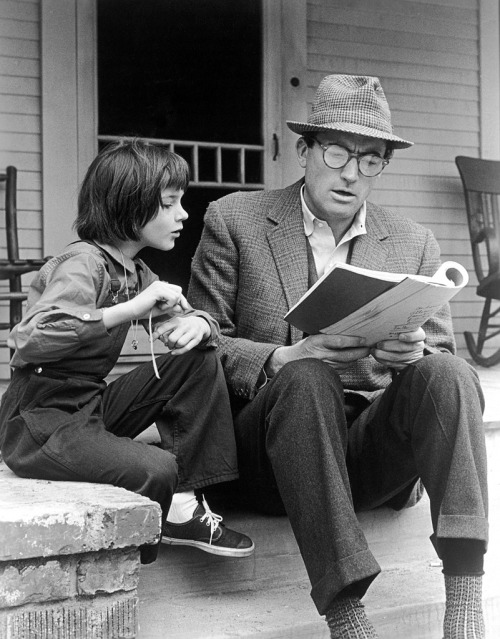 |
| I don't care what your teacher says, books aren't the devil |
3.
Humble Pie: Despite the fact that Atticus is one of the most respected residents of Maycomb County, he maintains a sense of humbleness throughout the film. For instance, when Scout asks him if they are poor, he readily admits that they are, rather than allowing her to go on believing otherwise. While many men would prefer to hide their financial difficulties from their children, Atticus chooses to face reality, simultaneously showing his children that a man's honor does not come from his money. He also refuses to use what little money he does have against those less fortunate than himself. For example, when Scout informs him that Mr. Cunningham has arrived to pay him, Atticus asks her to not mention it the next time he visits. Scout is confused by her father's secrecy and asks why he doesn't want to see Mr. Cunningham, to which he replies that he knows Mr. Cunningham is a proud man and doesn't want to force him into an embarrassing situation by accepting his payment in person. Similarly, he gratefully accepts the Cunninghams' payments of vegetables in lieu of money because he knows that they are paying him with the only resources that they have. He remains just as quiet about his own advantages as he does about others' disadvantages. Atticus is in fact so nonchalant about his talents that Jem is shocked to learn that his father, who he thought was "too old to do anything", is actually the best shot in the county. Most notably, Atticus is able to lose with humility when his client, Tom Robinson, is unjustly convicted at trial and avoids lashing out or blaming anyone else for the trial's outcome.
4.
Life Lessons: Throughout the film, Atticus instills in his children valuable life lessons. At one point , Jem tells his neighbor, Dill, "Atticus says cheating a black man is ten times worse than cheating a white man". This quote demonstrates that Atticus has already taught Jem the important lesson of why it is wrong to take advantage of those less fortunate than yourself. He teaches Scout equally valuable lessons when she complains that her teacher has forbidden her from reading. While many parents would be tempted to agree with Scout's conclusion that her teacher is acting foolish, he instead chooses to take the high road and explains that the teacher probably believes she is acting sensibly. He goes on to explain that "You never really understand a person until you consider things from his point of view...until you climb inside of his skin and walk around in it". Through this discussion, he prepares her for life beyond the classroom where she will have to get along with people of all walks of life, who may not share her point of view. Perhaps the most memorable of Atticus's life lessons comes when he tells Jem that his own father taught him that is a sin to kill a mockingbird. When Jem asks why mockingbirds are so special, Atticus goes on to explain that "they don't do anything but make music for us to enjoy. They don't eat people's gardens, don't nest in the corncribs; they don't do one single thing but sing their hearts out for us". It is only after Scout is saved by neighborhood outcast Boo Radley that the children learn the meaning of Atticus's story and realize that in life, as in nature, there are those who do their best to make the world a better place, and are often punished or misunderstood for their actions. It is at that point that Scout learns that there is perhaps no greater sin than destroying the mockingbirds of the world and depriving humanity of the good that they bring.
5.
Do As I Say And As I Do: The greatest lesson that Atticus teaches his children is one that they learn not from his words, but from his actions. One of the most crucial points in the film is when Atticus agrees to defend Tom Robinson, a black man falsely accused of raping a white woman. When Scout asks him, "do you defend niggers" after being picked on at school, he explains that he is defending Tom because if he didn't, "I couldn't hold my head up in town. I couldn't even tell you and Jem not to do something". By not only agreeing to defend Tom, but also doing so to the best of his ability, he shows Scout and Jem the importance of integrity. It would have been much safer for both Atticus and his children if he had refused to defend Tom or restricted himself to going through the motions at trial, but he chose not to take the easy way out. By upholding the principles that he teaches his children in his own life, he provides them with an example of how to live their lives. He also goes on to exemplify those same princples outside of the courtroom by treating those around him, from his colleagues, to his neighbors, to his housekeeper with dignity and understanding. Furthermore, Atticus sees himself and his family as equal to those around them, particularly in the eyes of the law. When he learns that Bob Ewell has been killed after attacking Scout and Jem, Atticus assumes that Jem committed the crime in self-defense. Rather than using his connections in the police force to cover up the crime and protect Jem, he instead determines to bring the case to the police and eventually to trial. It is then that his friend, Sheriff Tate, tells Atticus that Boo Radley killed Ewell, not Jem. This realization forces him to put aside one of his most cherished principles and hide the truth, not to protect Jem, but to ensure Boo's right to privacy. Through his willingness to put Boo's well being above his own sense of justice, Atticus upholds another of his principles in that he refuses to 'kill a mockingbird'. By witnessing how their father conducts himself in the various aspects of his life, Scout and Jem learn the importance of living with integrity in a compromised world. Although the film does not mention their adult lives, I like to believe that, with Atticus to guide them, Scout and Jem grew up to become true individuals who understood the world for what it was and saw it for what it could be.
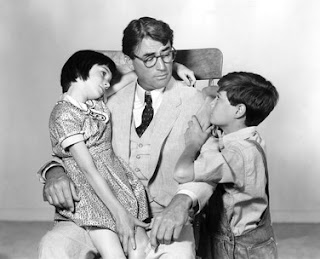 |
| Stop whining and you can narrate the next movie |
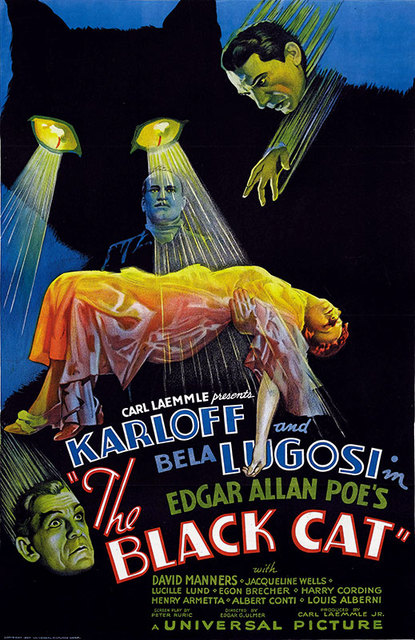 The Black Cat is certainly one of the most interesting horror films in Universal’s
famed horror cannon. Part revenge tale, part house haunting, and part
supernatural thriller, the film skims the surface of several genres without
ever becoming fully immersed in any of them. The film chronicles the efforts of
young newlyweds Joan and Peter Alison to escape from the house of a war
criminal turned satanic cult leader after being stranded by a car accident. The
couple is joined by the mysterious Dr. Werdegast (Bela Lugosi) who has come to
the house seeking revenge on its owner, Hjalmar Poelzig (Boris Karloff). Werdegast
was imprisoned and tortured in a prisoner of war camp run by former friend
Poelzig, and finally escaped only to find that his wife and daughter had
disappeared. While Werdegast executes an elaborate plan to have his revenge,
the Alison’s quickly realize that they are in for far more than local
hospitality when they are held as prisoners and Joan is selected as a sacrifice
for Poelzig’s satanic ritual.
The Black Cat is certainly one of the most interesting horror films in Universal’s
famed horror cannon. Part revenge tale, part house haunting, and part
supernatural thriller, the film skims the surface of several genres without
ever becoming fully immersed in any of them. The film chronicles the efforts of
young newlyweds Joan and Peter Alison to escape from the house of a war
criminal turned satanic cult leader after being stranded by a car accident. The
couple is joined by the mysterious Dr. Werdegast (Bela Lugosi) who has come to
the house seeking revenge on its owner, Hjalmar Poelzig (Boris Karloff). Werdegast
was imprisoned and tortured in a prisoner of war camp run by former friend
Poelzig, and finally escaped only to find that his wife and daughter had
disappeared. While Werdegast executes an elaborate plan to have his revenge,
the Alison’s quickly realize that they are in for far more than local
hospitality when they are held as prisoners and Joan is selected as a sacrifice
for Poelzig’s satanic ritual. 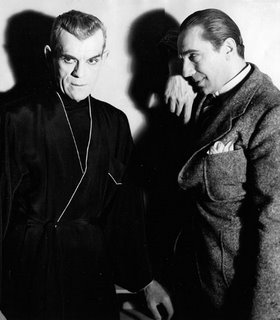
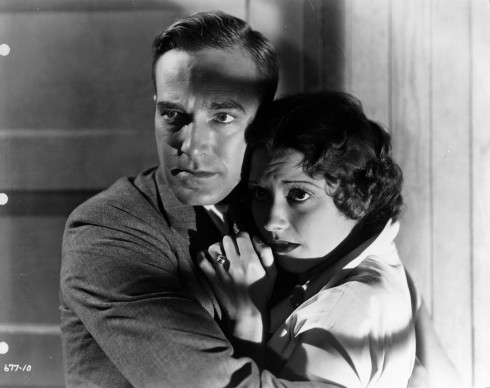







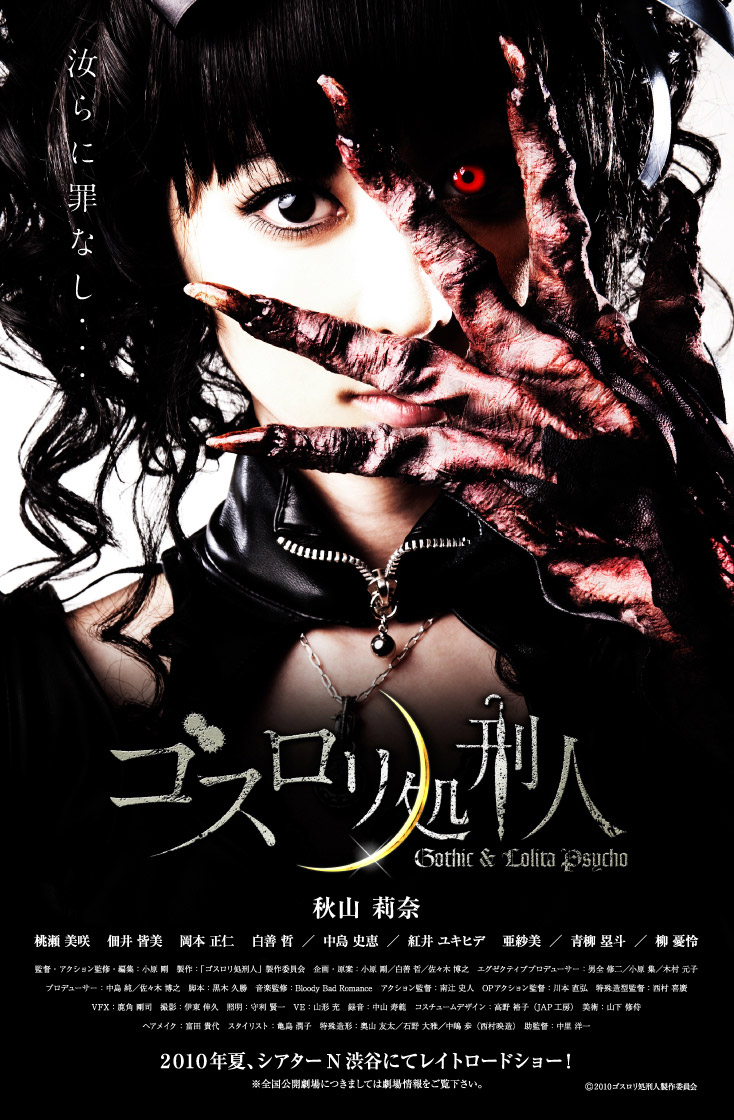









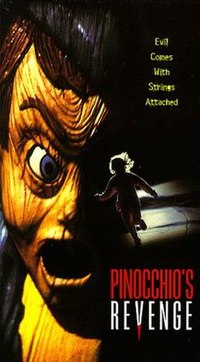



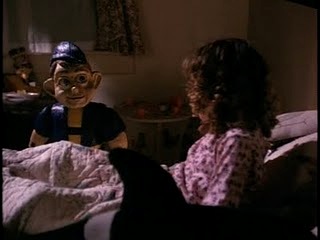

_01.jpg)

